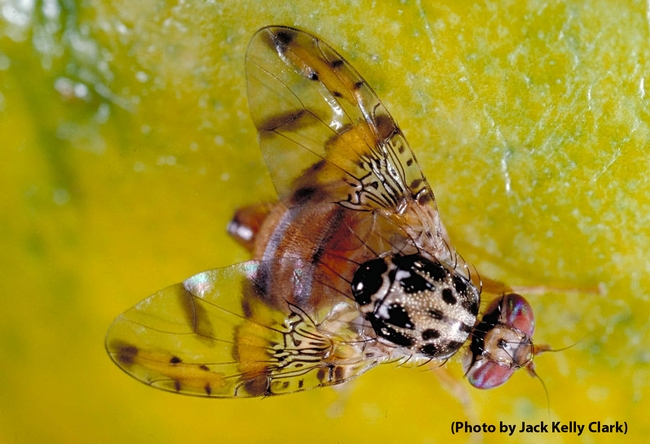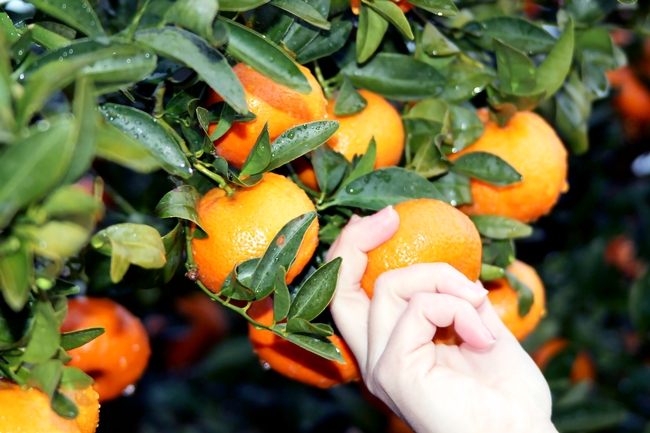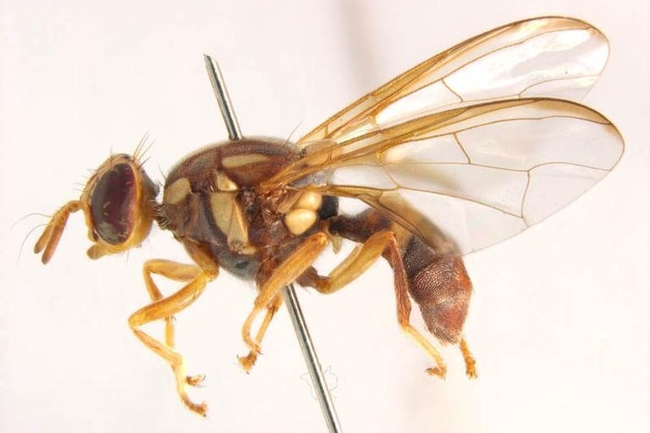
Posts Tagged: Mediterranean fruit fly
First-ever Queensland fruit fly quarantine restricts moving homegrown produce
QFF quarantine in LA, Ventura counties among seven fruit fly quarantines statewide
Residents in multiple Southern California and Northern California counties should not move homegrown fruits and vegetables from their properties to help contain several species of fruit fly that can destroy crops and impact the livelihoods of local farmers.
With sharing and gifting of food integral to the holiday season, the California Department of Food and Agriculture is reminding people to heed the seven active fruit fly quarantines aimed at controlling the Mediterranean fruit fly, Oriental fruit fly, Tau fly and Queensland fruit fly. The links below describe quarantine zone boundaries:
- Mediterranean fruit fly: Los Angeles County, Leimert Park Area
- Oriental fruit fly: San Bernardino and Riverside Counties, Redlands and Yucaipa Areas
- Oriental fruit fly: Sacramento County, Rancho Cordova Area
- Oriental fruit fly: Contra Costa County, Brentwood Area
- Oriental fruit fly: Santa Clara County, Santa Clara Area
- Tau fly: Los Angeles County – Stevenson Ranch, Valencia, Santa Clarita Areas
- Queensland fruit fly: Ventura and Los Angeles Counties, Thousand Oaks Area
People within these zones should consume or process (i.e., juice, freeze or cook) their homegrown fruits and vegetables at the place of origin and not move them off their property. Uneaten produce should be double-bagged in plastic bags and disposed of in the landfill bin – not compost or green waste.
Queensland fruit fly threatens California citrus, other crops
The Queensland fruit fly (Bactrocera tryoni) quarantine is the first of its kind in the U.S. Although QFF was first seen in California in 1985, the recent detection of two adult males triggered the unprecedented quarantine action by USDA's Animal and Plant Health Inspection Service and CDFA.
“This pest has earned a bad reputation for wreaking havoc on fruit production in Australia, where it is native,” said Hamutahl Cohen, University of California Cooperative Extension entomology advisor for Ventura County. “Adult flies lay their eggs in fruit, and the eggs hatch into larvae that then feed on the fruit, causing damage.”
And while females of other fruit fly species live for only two or three months, QFF females are unique in that they can live up to a year, according to Cohen.
“Once QFF populations take root, they're challenging to manage because females can each lay up to 100 eggs per day,” Cohen said.
In addition to being highly adaptable to a variety of environmental conditions, QFF has more than 170 host plants – including a wide range of California commodities such as citrus, grape, strawberry, fig, avocado, apricot, peach, cherry, nectarine, plum, pear, apple, tomato and sweet pepper.
The threat to citrus is especially concerning, as Southern California growers continue to grapple with the specter of spreading huanglongbing (HLB) disease, which kills citrus trees. Cohen said residents of citrus-growing regions can do their part to help their neighbors and local economy by respecting quarantine restrictions.
“Growers are already dealing with other invasive species like Asian citrus psyllid [vector of HLB pathogen], so we as homeowners need to prevent the spread of fruit flies to reduce the burden on them,” she explained.
While a spike this year in the detections of multiple fruit fly species was likely caused by a host of factors, Cohen speculates that increased post-pandemic travel is helping to move the flies. And with holiday travel in full swing, she said it's important to practice “Don't Pack a Pest” principles.
“Invasive species often hitchhike on fruits and vegetables brought into California by travelers – that's why we often first find invasive species in urban and suburban backyards, and not on farms,” Cohen said. “Travelers entering the U.S. can visit dontpackapest.com to learn about which products they can and cannot bring back with them.”
To report a suspected infestation of fruit fly larvae in homegrown produce, call the CDFA pest hotline at 1-800-491-1899. Growers with questions and concerns are urged to contact their local agricultural commissioner's office.
The Medfly 'Through the Decades': Tune in to Hear Professor Carey on July 3
Remember when scientists first detected the Mediterranean fruit fly in California? It was the early 1980s. The invasive insect, better known as the medfly (Ceratitis capitata), threatened the state's multi-billion-dollar fruit and vegetable industry, leading to widespread detection, eradication...

Distinguished Professor James R. Carey is known for his outstanding research, outreach and advocacy program involving invasion biology, specifically the Mediterranean Fruit Fly (medfly) and the Light Brown Apple Moth (LBAM). (Photo by Kathy Keatley Garvey)
Of Medflies and Light Brown Apple Moths
Congratulations to James R. Carey, distinguished professor of entomology at the UC Davis Department of Entomology and Nematology for his public service award! He has just been named a recipient of a Distinguished Scholarly Public Service Award from the UC Davis Academic Senate for his "outstanding...

UC Davis Distinguished Professor James R. Carey with some of the maps he used in his research. (Photo by Kathy Keatley Garvey)
Medflies: Permanent Residents
Breaking news shook the agricultural world today. The Mediterranean fruit fly, considered the world's worst agricultural pest, is one of at least five fruit flies established in California. It cannot be eradicated. So says entomologist James Carey of the UC Davis Department of Entomology and...

Mediterranean Fruit Fly. (Photo by Jack Kelly Clark)
The Invasion of Tropical Fruit Flies
From a trickle to a flood. But why? Professor James R. Carey of the UC Davis Department of Entomology will tell you why. He will discuss the invasion of tropical fruit flies in California at his seminar from 12:05 to 1 p.m., Wednesday, April 3 in Room 1022 of the Life Sciences Addition, corner of...

Mediterranean Fruit Fly. (Photo by Jack Kelly Clark)


